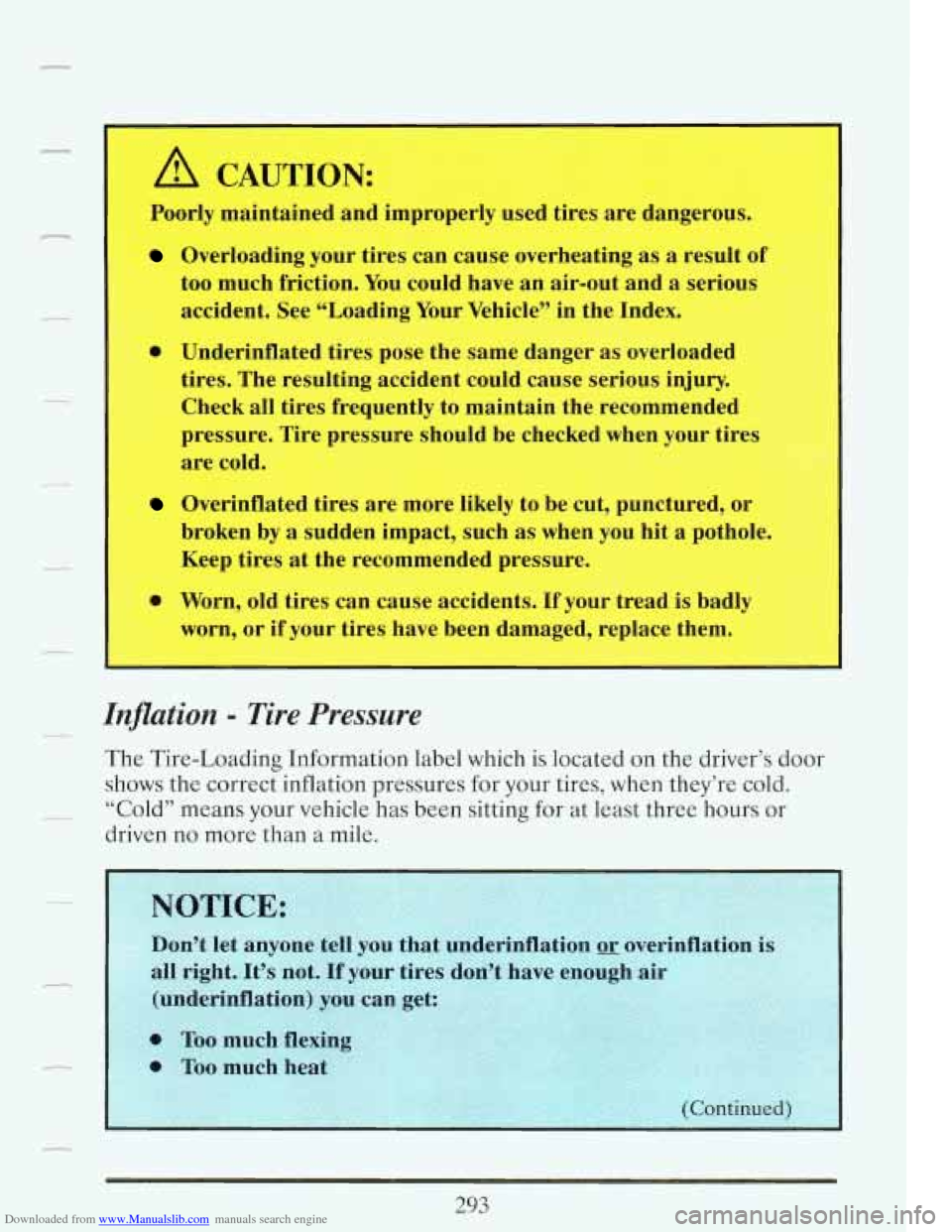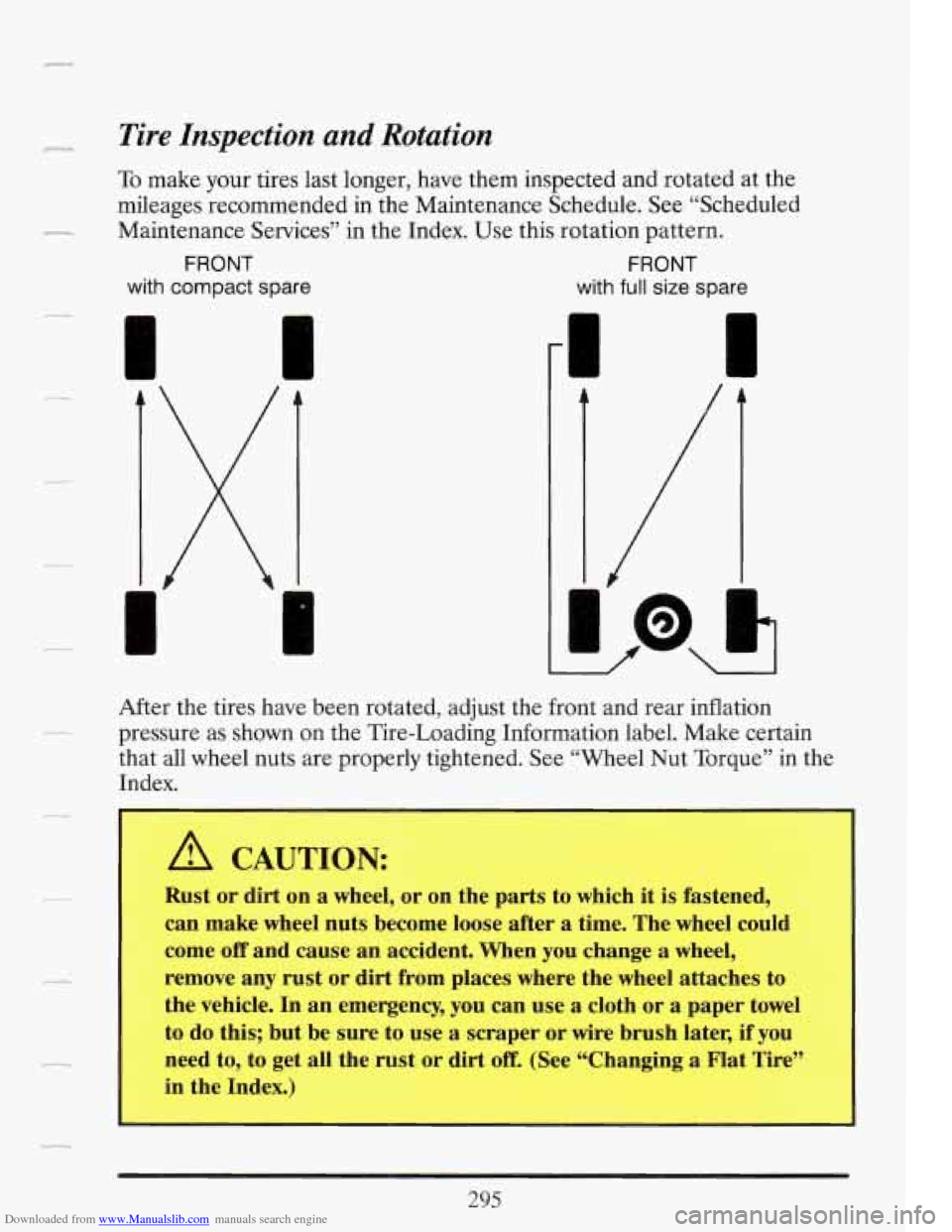Page 262 of 386
Downloaded from www.Manualslib.com manuals search engine Align the upper
locator pins and insert
-
the pins into the holes. .
n
Push the handles up to lock the skirt in place.
COMPACT SPARE TIRE
Although the compact spare was fully inflated when your vehicle was
new, it can lose air after a time. Check the inflation pressure regularly. It
should be
60 psi (420 kPa). The compact spare is made to go up to 3,000 -
miles (5000 km), so you can finish your trip and have your full-size tire i* u
repaired or replaced where you want. Of course, it’s best to replace your I
spare with a full-size tire as soon as you can. Your spare will last longer
and be in good shape in case you need it again.
Your anti-lock brake system warning light may come on when
you are
driving with a compact spare. See “Anti-Lock Brake System Warning
Light” in the Index.
Don’t use your compact spare on some other vehicle.
248
Page 304 of 386
Downloaded from www.Manualslib.com manuals search engine I
3. Reinstall the new
insert by aligning
the blade housing
tabs and the edge
of the insert. Make
sure that the insert
is connected to all
the housing tabs.
4. Install the wiper blade assembly to the wiper arm.
LOmING YOUR VEHICLE
OCCUPANTS VEHICLE CAP.
WT.
TIRE-LOADING INFORMATION
FRT. CTR.
RR. TOTAL LBS. KG
MAX. LOADING & GVWR SAME AS VEHICLE
CAPACITY WEIGHT XXX COLD TIRE
TIRE
SIZE SPEED PRESSURE RTG
PSVKPa
FRT.
R R.
SPA.
IF TIRES ARE HOT. ADD 4PSV28KPa SEE
OWNER’S MANUAL FOR ADDITIONAL
INFORMATION
GEN GME
Two labels on your vehicle show how much weight it may properly carry.
The Tire-Loading Information label found on the driver’s door tells you
the proper size, speed rating and recommended inflation pressures for
n
290
Page 307 of 386

Downloaded from www.Manualslib.com manuals search engine A CAUTION:
i --
Poorly maintained and improperly used tires are dangerous.
Overloading your tires can cause overheating as a result of
I
too much friction. You could have an air-out and a serious
accident. See “”Loading Your Vehicle” in the Index.
0 Underinflated tires pose the same danger as overloaded
tires. The resulting accident could cause serious injury.
Check all tires frequently
to maintain the recommended
pressure. Tire pressure should
be checked when your tires
are cold.
I
I Overinflated tires are more likely to be cut, punctured, or
broken by
a sudden impact, such as when you hit a pothole.
Keep tires at the recornmended pressure.
@ Worn, old tires can cause accidents. If your tread is badly
worn, or if your tires have been damaged, replace them.
Inflation - Tire Pressure _c
The Tire-Loading Information label which is located on the driver’s door
shows the correct inflation pressures
for your tires, when they’re cold.
driven no more than a mile.
- “Cold’’ means your vehicle has been sitting for at least three hours or
293
Page 309 of 386

Downloaded from www.Manualslib.com manuals search engine P Tire Inspection and Rotation
To make your tires last longer, have them inspected and rotated at the
mileages recommended in the Maintenance Schedule. See “Scheduled
- Maintenance Services” in the Index. Use this rotation pattern.
FRONT FRONT
with compact spare
with full size spare
cs
r
A
I
After the tires have been rotated, adjust the front and rear inflation
pressure as shown on the Tire-Loading Information label. Make certain
that all wheel nuts are properly tightened. See “Wheel Nut Torque” in the
Index.
A CAUTION:
Rust or dirt on a wheel, or on the parts to which it is fastened,
can make wheel nuts become loose after a time. The wheel could
come
off and cause an accident. When you change a wheel,
remove any rust
or dirt from places where the wheel attaches to
the vehicle. In an emergency, you can use
a cloth or a paper towel
to do this; but be sure to use a scraper
or wire brush later, if you
need to, to get all the rust
or dirt off. (See “Changing a Flat Tire”
in the Index.)
295